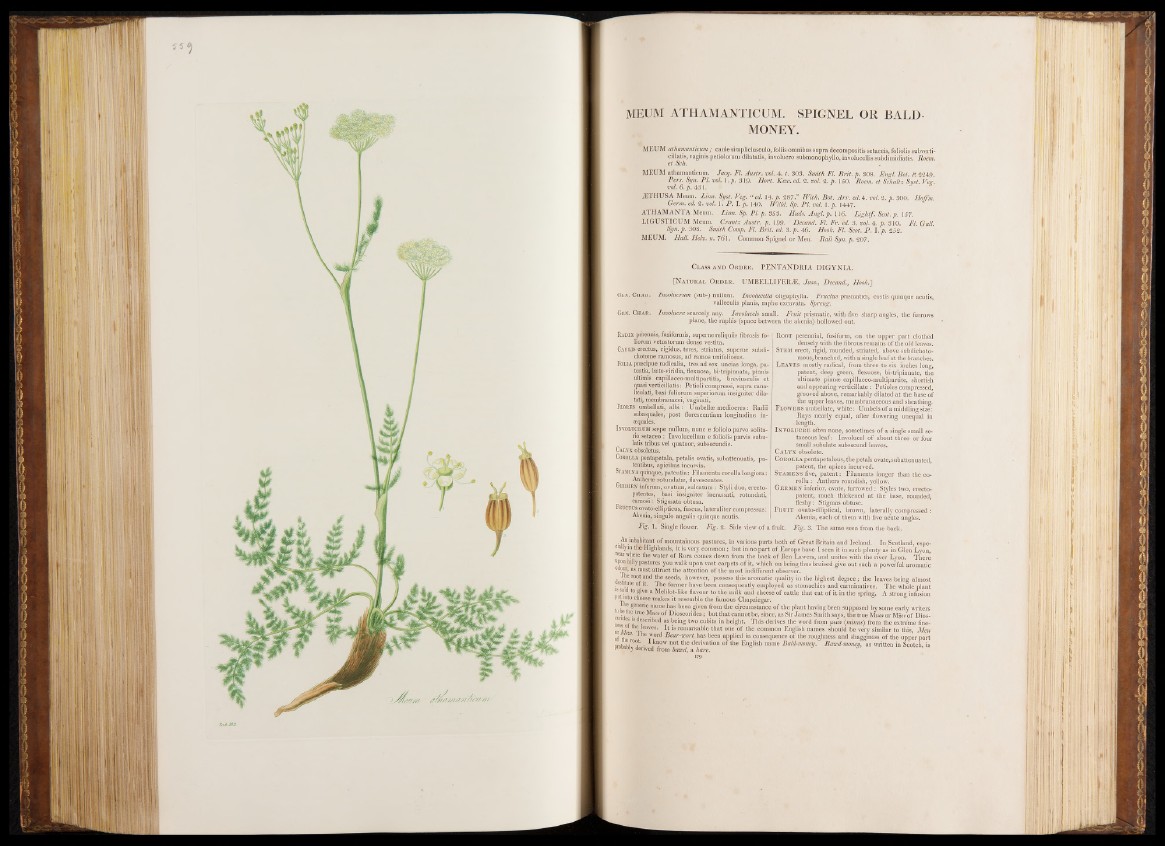
MEUM ATHAMANTIC UM. SPIGNEL OR BALD-
MONEY.
MEUM athamanticum ; caule simpliciusculo, foliis omnibus supra decompositis setaceis, foliolis subverti-
cillatis, vaginis petiolorum dilatatis, involucro submonophyllo, involucellis subdimidiatis. Roem.
et Sch.
MEUM athamanticum. Jacq. Ft. Austr. ml. 4. t. 303. Smith Fl. Brit. p. 308. Evgl. Bot. f. 2249.
Pers. Syn. PL ml. 1. p. 319. Hort. Kero. ed. 2. ml. 2. p. 150. Roem. et Schultz Sust. Veg.
ml. 6. p . 431.
jETHUSA Meum. Linn. Syst. Veg. “ ed. 14. p. 287.” With. Bot. Arr. ed.4. m l.2 .p . 300. Hofm.
Germ. ed. 2. ml. 1. P . l .p . 140. Willd. Sp. PI. vol. 1 .p . 1447.
ATHAMANTA Meum. Linn. Sp. PI. p . 353. Huds. Angl. p. 11(5. Light/. Scot. p. 157.
LIGUSTICUM Meum. Crantz Austr. p. 199. Decatid. Fl. Fr. ed. 3. vol. 4. p. 310. Fl. Gall.
Syn. p . 308. Smith Comp. Fl. Brit. ed. 3. p. 46. Hook. Fl. Scot.. P . l . p. 252.
MEUM. Hall. Helv. n. 7 6 1. Common Spignel or Meu. Raii Syn. p. 207.
Class a nd O rd e r . PENTANDRJA DIGYNIA.
[N atural Ord er . UMBELLIFERJE, J uss., Decand., Hook.]
Gen. Char. Involucrum (sub-) nullum. Lnvolucella oligophylla. Fructus prismatici, costis quinque acutis,
. valleculis planis, raphe excavata. Spreng.
Gen. Char. Involucre scarcely any. Involucels small. Fruit prismatic, with five sharp angles, the furrows
plane, the raphis (space between the akenia) hollowed out.
Radix pérennis, fusiformis, superne reliquiis fibrosis fo- 1
liorum vetustorum dense vestita.
Caulis erectus, rigidus, teres, striatus, superne subdi-
chotome ramosus, ad ramos unifoliosus.
Folia præcipue radicaiia, tres ad sex uncias longa, pa-
tentia, læte-viridia, flexuosa, bi-tripinnata, pinnis
ultimis eapillaceo-multipartitis, breviusculis et
quasi verticillatis: Petioli compressi, supra cana-
liculati, basi foliorum superiorum insigniter dila-
tati, membranacei, vaginati.
Flores umbellati, albi : Umbellæ mediocres : Radii
suboequales, post florescentiam longitudine in-
æquales.
Involucrum so?pe nullum, nunc e foliolo parvo solita-
rio setaceo : Involucellum e foliolis parvis subu-
latis tribus vel quatuor, subsecundis.
Calyx ob'soletus.
Corolla pentapetala, petalis ovatis, subattenuatis, pa-
tentibus, apicibus incurvis.
Stamina quinque, patentia: Filamenta corollalongiora:
Antheroe rotundatæ, flavescentes.
Germen inferum, ovatum, sulcatum : Styli duo, erecto-
patentes, basi insigniter incrassati, rotundati,
carnosi : Stigmata obtusa.
Fructus ovato-ellipticus, fuscus, lateralitercompressus:
I Root perennial, fusiform, on the upper part clothed
Akenia, singulo angulis quinque acutis.
Fig. 1. Single flower. Fig. 2. Side view of a :
densely with the fibrous remains o f the old leaves.-
Stem erect, rigid, rounded, striated, above subdichoto-
mous, branched, with a single leaf a t the branches.
Leaves mostly radical, from three to six inches long,
patent, deep green, flexuose, bi-tripinnate, the
ultimate pinnas capillaceo-multipartite, shortish
and appearing verticillate: Petioles compressed, •
grooved above, remarkably dilated at the base of
the upper leaves, membranaceous and sheathing.
Flowers umbellate, white: Umbels of a middling size:
Rays nearly equal, after flowering unequal in
(.length.
I nvolucre often none, sometimes of a single small setaceous
leaf: Involucel of about three or four
small subulate subsecund leaves.
Calyx obsolete.
Corolla pentapetalous, the petals ovate,subattenuated,
patent, the apices incurved.
Stamens five, patent: Filaments longer than the corolla
: Anthers roundish, yellow.
Germen inferior, ovate, furrowed : Styles two, erecto-
patent, much thickened at the base, rounded*
fleshy: Stigmas obtuse.
F ru it ovato-elliptical, brown, laterally compressed :
Akenia, each of them with five acute angles,
fruit. Fig. 3. The same seen from the back.
■ ^n.lnhabltaPt of mountainous pastures, in various parts both of Great Britain and Ireland. In Scotland, especially
in the-Highlands, it is very common; but in no part of Europe have I seen it in such plenty as in Glen Lyon,
near tbe water of Rora comes down from the back of Ben Lawers, and unites with the river Lyon. There
upon hilly pastures you walk upon vast carpets of it, which on being thus bruised give out such a powerful aromatic
■ r> as must attract the attention of the most indifferent observi
The root and the seeds, however, possess this aromatic quality in the highest degree; the leaves being almost
is ‘d gf f r The former have been consequently employed as stomachics and carminatives. The whole plant
M f t0 p ve a Melilot-like flavour to the milk and cheese of cattle that eat of it in the spring. A strong infusion
put into cheese makes it resemble the famous Chapziegar.
to I I ^6ner'C name bas. been given from the circumstance of the plant having been supposed by some early writers
corid ■ T of Dioscorides; but that cannot be, since, as Sir James Smith says, the true Muon or Mijo/of Dios-
nexs n f!? ,scilbed as being two cubits in height. This derives the word from puov (minus) from the extreme fine-
orAf a [eaves> It is remarkable that one of the common English names should be very similar to this, Meu
of thpr I n i P f ^ ear'wort bas been applied in consequence of the roughness and shagginess o f the upper part
nmhoM (HI • * cnow not the derivation of the English name Bald-money. Bawd-money, as written in Scotch, is
proDably derived from bawd, a hare.